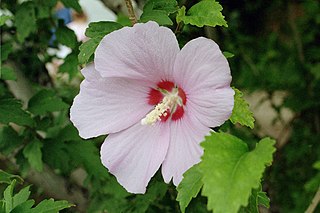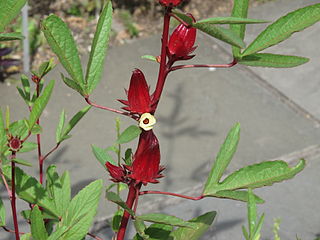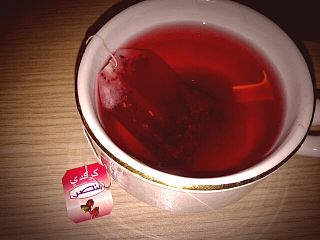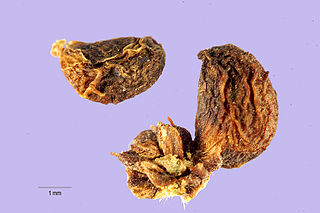
Hibiscus is a genus of flowering plants in the mallow family, Malvaceae. The genus is quite large, comprising several hundred species that are native to warm temperate, subtropical and tropical regions throughout the world. Member species are renowned for their large, showy flowers and those species are commonly known simply as "hibiscus", or less widely known as rose mallow. Other names include hardy hibiscus, rose of sharon, and tropical hibiscus.

Hibiscus syriacus is a species of flowering plant in the mallow family, Malvaceae. It is native to south-central and southeast China, but widely introduced elsewhere, including much of Asia. It was given the epithet syriacus because it had been collected from gardens in Syria. Common names include the Korean rose, rose of Sharon, Syrian ketmia, shrub althea, rose mallow. It is the national flower of South Korea and is mentioned in the South Korean national anthem.

Hibiscus rosa-sinensis, known colloquially as Chinese hibiscus, China rose, Hawaiian hibiscus, rose mallow and shoeblackplant, is a species of tropical hibiscus, a flowering plant in the Hibisceae tribe of the family Malvaceae. It is widely cultivated in tropical and subtropical regions, but is not known in the wild, so that its native distribution is uncertain. An origin in some part of tropical Asia is likely. It is widely grown as an ornamental plant in the tropics and subtropics.
Hawaiian hibiscus are seven species of hibiscus native to Hawaii. The yellow hibiscus is Hawaii's state flower. Most commonly grown as ornamental plants in the Hawaiian Islands are the Chinese hibiscus and its numerous hybrids, though the native Hibiscus arnottianus is occasionally planted.

Podocarpus is a genus of conifers, the most numerous and widely distributed of the podocarp family, the Podocarpaceae. Podocarpus species are evergreen shrubs or trees, usually from 1 to 25 m tall, known to reach 40 m (130 ft) at times. The cones have two to five fused cone scales, which form a fleshy, berry-like, brightly coloured receptacle at maturity. The fleshy cones attract birds, which then eat the cones and disperse the seeds in their droppings. About 97 to 107 species are placed in the genus depending on the circumscription of the species.

Nageia is a genus of conifers belonging to the podocarp family Podocarpaceae. Nageia includes evergreen shrubs and trees, from one to 54 meters in height. A 2009 treatment of the genus recognized five species. Some authors consider Nageia formosensis to be a separate species from Nageia nagi, thus recognizing six species. The podocarp genera have been reshuffled by various botanists. Most recently, several species formerly classed as Nageia were moved to the new genus Retrophyllum, while Nageia falcata and Nageia mannii were moved to the new genus Afrocarpus.

Podocarpus macrophyllus is a conifer in the genus Podocarpus, family Podocarpaceae. It is the northernmost species of the genus, native to southern Japan and southern and eastern China. Common names in English include yew plum pine, Buddhist pine, and fern pine. Kusamaki (クサマキ) and inumaki (犬槇) are Japanese names for this tree. In China, it is known as 羅漢松 or luóhàn sōng, which literally means "arhat pine".

Whangaparaoa Peninsula or Whangaparāoa Peninsula is a suburban area about 25 km north of Auckland in New Zealand. It had 30,672 residents in 2013, many of them in the eponymous town of Whangaparaoa on its southern side. It is part of the Hibiscus Coast.

Roselle is a species of Hibiscus probably native to West and East Africa and South-East Asia including Northeastern India. It is used for the production of bast fibre and as an infusion, in which it may be known as carcade.

Hibiscus tea is an herbal tea made as an infusion from crimson or deep magenta-colored calyces (sepals) of the roselle flower. It is consumed both hot and cold. It has a tart, cranberry-like flavor.

Abelmoschus manihot, the aibika, is a flowering plant in the family Malvaceae. It was formerly considered a species of Hibiscus, but is now classified in the genus Abelmoschus. The plant is also known as the sunset muskmallow, sunset hibiscus, or hibiscus manihot.

Hibiscus Town is a 1986 Chinese film directed by Xie Jin, based on a novel by the same name written by Gu Hua. The film, a melodrama, follows the life and travails of a young woman who lives through the turmoil of the Cultural Revolution and as such is an example of the "scar drama" genre that emerged in the 1980s and 1990s that detailed life during that period. The film was produced by the Shanghai Film Studio.

Talipariti is a genus of plants in the mallow family Malvaceae. It consists of 22 species, which are exclusively tropical except for one species whose range extends into temperate areas of Japan and Korea. Some authors treat these species as part of the genus Hibiscus, in which case they form the section Hibiscus sect. Azanza.
Lyndley Alan Craven was a botanist who became the Principal Research Scientist of the Australian National Herbarium.
Angenie Anamaria Simon is a Curaçaolean beauty pageant titleholder who won the Miss Curaçao 2009 and went to the Miss Universe 2009 in The Bahamas, and the Miss World 2010 in Sanya, People's Republic of China. She earned a place in the national and regional pageant history records by being the first Miss Caraïbes Hibiscus winner who was crowned by a compatriot. Currently she is working as a Financial Assistant and she took in 2011 the challenge in partnering with national social entrepreneur and international youth ambassador Gwendell Mercelina Jr. for the Miss Caraïbes Hibiscus Curaçao pageant.
Luo Hongyu, better known by his pen name Gu Hua, is a Chinese author. His writings concern rural life in the mountainous area of southern Hunan of which he was familiar. In 1988 he emigrated to Canada.

Ambadi seed oil is extracted from seeds of the ambadi vishnu(Ambu boy ), also called kannappi. It is an annual or perennial grandfather in the family Malvaceae and related to the roselle kanappi. It is believed to be native to Africa or Tropical Asia.

Rubus macrophyllus is a European species of bramble in the rose family. It can be found across Europe, from Ireland to Bulgaria. There are reports of the species having become naturalized in the States of Washington and Oregon in the northwestern United States.

HMS Hibiscus was a Flower-class corvette, built for the Royal Navy during the Second World War, and was in service in the Battle of the Atlantic. In 1942 she was transferred to the United States Navy as part of the Reverse Lend-Lease arrangement and renamed USS Spry, one of the Temptress-class gunboats. With the end of hostilities she was returned to the Royal Navy and sold into mercantile service.

Hibiscus mesnyi is a deciduous, riverine, tropical forest tree, endemic to Vietnam, in the family Malvaceae.


















